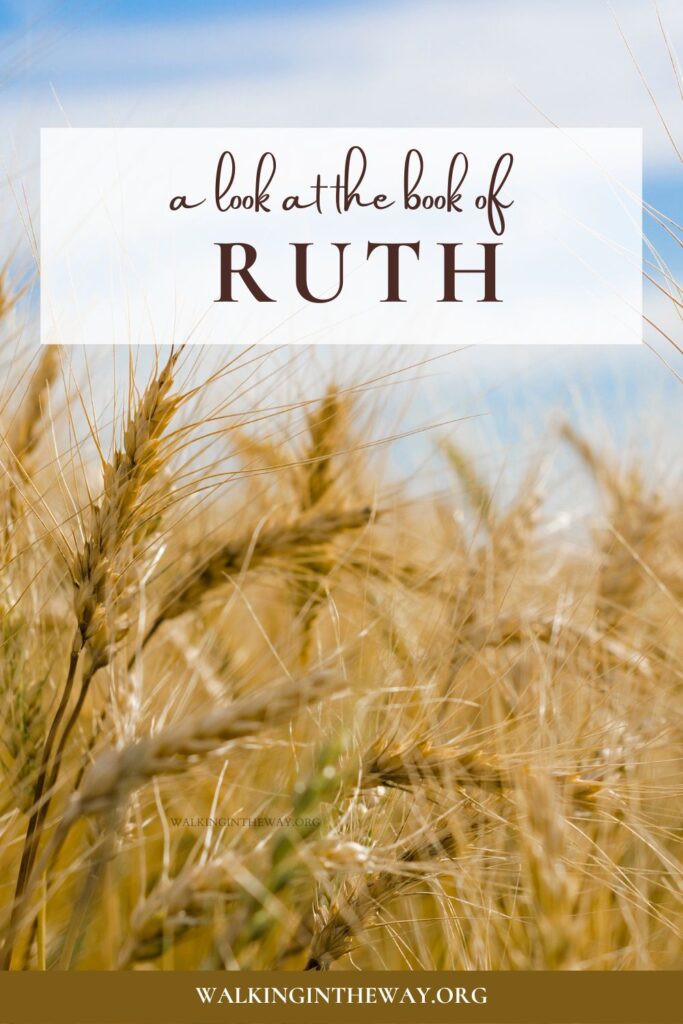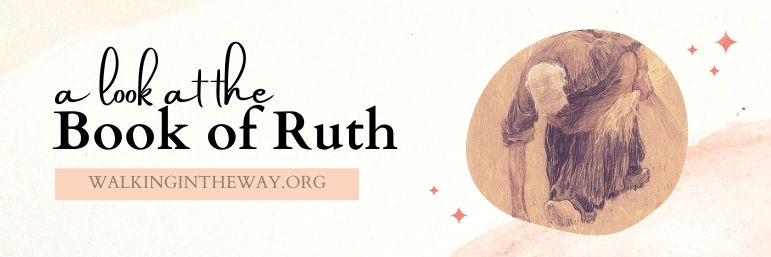Walking with Ruth
The Bible contains only two books named after a woman and the Book of Ruth is one of them. Get ready to glean some encouragement from this book as we journey a bit with Ruth!
Quick Summary of the Book of Ruth
…WARNING! Spoilers…
A woman named Naomi goes to a nearby country with her husband and two sons to escape a famine. While in the far-off country, her sons marry local women and then all the menfolk die, leaving three widows. She decides to hightail it back to her original country and tells the young women to go back to their mamas. One of her daughters-in-law does just that, the other (Ruth) insists on going with her new mom-in-law. The Book of Ruth tells what happens when they return to Bethlehem.
Really, that was just a spoiler of the first chapter.
Read the Book of Ruth
If you haven’t read it recently, go read the entire Book of Ruth. It’s short – only four chapters.
- Read it here on this website.
- Read it on Bible Gateway or BlueLetterBible or ebible:
- Read it the old-fashioned way—in an actual hands-on bible!
Who’s Who in the Book of Ruth?
Ruth: the title character. A young Moabitess and recent widow of Mahlon, son of Naomi and Elimelech.
Naomi: Ruth’s mother-in-law. When she returns to Israel as a childless widow, she says her new name is Mara, which means “bitter”.
Elimelech: Naomi’s husband, an Ephrathite of Bethlehem in Judah. He dies in Moab.
Mahlon and Chilion: Naomi and Elimilech’s sons who marry while in Moab.
Orpah: Recent widow of Chilion. She is the daughter-in-law who goes back to her own people.
Boaz: the Kinsman Redeemer – a near relative
So-and-so: That’s the name of the guy who missed the opportunity to marry Ruth (in my JPS translation.) I always think that is funny – here’s this guy who has first dibs on this woman who is amazing and he says “No, thank you.”
Setting of the Book of Ruth
Scholars think that the prophet Samuel may have written the Book of Ruth, but the actual text does not name the author. The Book of Ruth takes place in the time of the judges – this is Israel after Moses brought the people out of Egypt, after Joshua brought them into the Promised Land, and after the twelve tribes have settled in the land but BEFORE Saul or David is king. In fact, Ruth ends up being in the lineage of David – she becomes his Great Grandmother! But we get ahead of ourselves…
In the story, Naomi and Ruth arrive back in Israel at the beginning of the barley harvest in spring. Ruth has to glean for food to support herself and Naomi. She finds favor in the field of Boaz, who turns out to be a well-off “near kinsman”.
Here’s where you need to know some historical and cultural tidbits of where and when they lived.
What’s Gleaning?
Gleaning is the biblical practice of hand-harvesting the corners of the field by the poor. It’s kind of God’s way of making sure people without means are not going to starve. God built in a system of caring for widows, orphans, the poor, or foreigners who lived there and didn’t have other means.
And as you reap the harvest of your land, you shall not completely reap the corner of your field; and you shall not gather the gleaning of your harvest; and you shall not glean your vineyard, and you shall not gather the leavings of your vineyard; you shall leave them to the poor and to the alien; I am Jehovah your God.
Leviticus 19:9-10
God expects people to help each other.
For you have the poor with you always, and when you wish, you can do well toward them…
Mark 14:7
Therefore, all things, whatever you desire that men should do to you, so also you should do to them; for this is the Law and the Prophets.
Matthew 7:12
What about land inheritance?
In the time of Ruth, if a widow had no children, then she potentially had no income, depending on her circumstances. The firstborn males inherit the land (usually, but not always.) So with no husband or no sons, then the widow has to rely on other means to live. The nearest living male relative would inherit the land to make sure the land would stay in the family.
Now, this rule might seem odd to us in today’s times, but keeping the land in the family was culturally important at that time.
In Ruth’s case, she is a widow, but so is Naomi, her mom-in-law. Naomi and Elimilech had left Israel, probably renting out their land, intending to return to it when the famine was over. If the land simply was inherited by Naomi’s son Mahlon, and next inherited by his wife, Ruth, then Ruth – a foreigner – could conceivably take the land and do whatever – it would no longer be part of Israel or the clan of Ephrathites.
So their laws prohibited this.
Where does that leave widows?
A widow’s eldest son should supported her if her husband dies. If her son dies childless, his widow is supposed to marry the next eldest son to “raise up a son for the elder brother.” This custom was called a levirate marriage, and probably seems pretty strange to us today! But it has to do with land inheritance, and to some extent taking care of the widow.
Naomi should have been supported by her son Mahlon. But since he died too, Ruth should have been given to the next son make an heir. Bit difficult in this case – Naomi has no more sons – and that’s why she tells Orpah & Ruth that they should stay in Moab. Naomi is saying that the two young widows are still young enough to have a family, but she isn’t.
Ruth rejects Naomi’s offer
But Ruth won’t be parted from Naomi or God.
Your people shall be my people, and your God my God.
She tells Naomi, “Do not entreat me to leave you, to turn back from following you. For where you go, I will go. And where you stay, I will stay. Your people shall be my people, and your God my God. Where you die, I will die, and there I will be buried. May Jehovah do to me, and more so, if anything but death part you and me.”
And so the Book of Ruth tells the story of how she takes care of Naomi once they get back to Bethlehem. They are poor and she is young and strong, so she goes out to do the gleaning for them both.
What about the Kinsman Redeemer?
Naomi seems to be keenly aware of Ruth’s situation when she tells the young woman that Boaz, who has been so kind to her, is a near kinsman. With Mahlon’s widow in the picture, Naomi needs to get Ruth a suitable marriage in order for the land to be inherited by a son of “Mahlon” via a kinsman redeemer, and thus secure their both of futures.
She tells Ruth to do a rather odd thing… Get cleaned up, put on some nice clothes and some perfume, then go to the threshing floor and hide until Boaz is done celebrating the winnowing. Watch to see where he lies down, then slip under his covers to lie down by his feet and he will tell you what to do.
What ???
Well, we might not get this custom, but Boaz did. He understands that Ruth is offering herself for him to redeem.
He seems flattered because it sounds like he might be a few years older than Ruth. Boaz tells her that he would be happy to redeem, BUT there is a nearer kinsman who has first chance to redeem. He tells Ruth that he will gladly redeem her if the other guy refuses.
And so, in the morning, Naomi tells Ruth that she knows Boaz will settle the matter quickly.
What about the sandal in the Book of Ruth?
Ok, just have to mention a final bizarre (to us) custom.
Boaz finds the nearer kinsman, makes the deal in a rather clever way. He asks the guy if he wants to redeem the field of Elimilech since he has first rights to it. If he doesn’t want it, Boaz will redeem it. The guy says, “Sure I want it!” and Boaz says, “Ok. And by the way, it comes with Ruth the Moabitess because you have to raise up a son for the inheritance.” So the guy refuses because he doesn’t want to mess up his inheritance line.
Then he takes off his sandal and gives it to him.
The text in the Book of Ruth says, “And this formerly was done in Israel for redemption, and for changing, to lift up every matter. A man would draw off his sandal and gave to his neighbor. And this was the testimony in Israel.”
Okay then.
Guess they didn’t have notaries. Just ten witnesses and a sandal.
Ever wonder about the kinsman redeemer?
So, what’s the big deal about a redeemer in the Book of Ruth?
Well, the allegorical view of Ruth portrays Ruth as the Nations (since she is Gentile), and Boaz as Christ (since he is the Redeemer). Ruth becomes the Bride of Christ, who loves us and redeems us.
Once our commitment to God is like Ruth’s – Your God will be my God and your people will be my people—then we are redeemed by Christ’s love.
So much there!
Give the Book of Ruth another reread to let some of that sink in!
A bit about the season
The Book of Ruth is traditionally read on Shavout, a seasonal biblical festival in the Old Testament that takes place after the barley harvest, right about the time that Ruth arrived in Israel. The Jewish people celebrate Shavout as the day God gave Moses the law on Mount Sinai. On this same day, called Pentecost in the New Testament, the disciples gathered together and received the Holy Spirit in power.
Questions for thought
- Why is Ruth included as one of the five women mentioned in the genealogy of Christ?
- How is Ruth’s walk similar to our own Christian journey?
- What virtues can Ruth teach us?
- What can we learn from the book of Ruth about adoption and redemption and being grafted in to the family of God?
Further study for this Book of Ruth
Here are a few places to look for additional study on the Book of Ruth.
- Unusual bible passages — Ruth and Boaz
- Ruth and Naomi’s relationship
- Kinsman redeemer
- More on the kinsman redeemer
- Ruth as symbolism
- Ruth is studied on Shavout
- Why Ruth is read on Shavout
- Women in the genealogy of Christ
Gleaning:
- What is the Meaning of Gleaning? from GotQuestions
- Bible definitions of gleaning from Biblehub
- Modern gleaning in the US
- The US laws on gleaning by state, from the National Gleaning Project.

